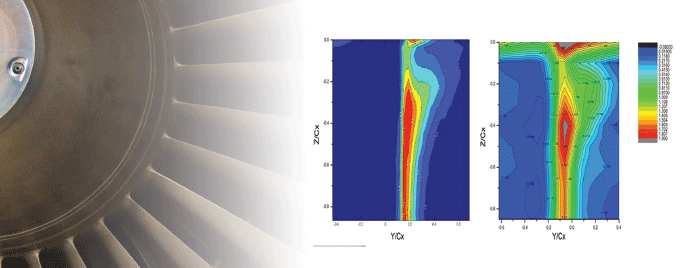Simulations conducted by a research team led by Mounir Ibrahim at Cleveland State University depicts total pressure loss comparisons downstream of the trailing edge in an airfoil passage (left: experiment, right: CFD).
The flow in the endwall region of a compressor or turbine airfoil passage contains a complex system of vortices, which interact with each other and produce undesirable effects, including the disruption of cooling flows and the generation of aerodynamic losses. With unshrouded airfoils, the tip endwall region also includes leakage through the clearance between the rotor blade tips and the turbine casing. This tip gap leakage can cause undesirable heat transfer and interact with the rest of the endwall flow to increase secondary losses. Endwall flows are further complicated by periodic unsteadiness as airfoils move through the wakes shed by upstream airfoils. The velocity deficit and elevated turbulence in the wakes affect the flow on the airfoil surfaces and at the endwalls.
“Many studies have considered endwall flows, and several methods have been proposed for flow modification and secondary loss reduction,” said Mounir Ibrahim, Ph.D., chair and professor of mechanical engineering at Cleveland State University (CSU) and director of the Power and Energy Systems Lab at CSU’s Fenn College of Engineering. “The flow is still very complex and not completely understood, particularly with regard to periodic unsteadiness. A more complete understanding allows for better flow management, leading to reduced losses and heat transfer. This will lead to increased engine efficiency, resulting in reduced emissions, fuel consumption and operating cost.”
Ibrahim’s research team, in collaboration with Ralph Volino, Ph.D., a professor of mechanical engineering at the U.S. Naval Academy (USNA), is investigating the endwall flow in a turbine passage. Cases with and without tip gaps and tip flow control are being evaluated, including both experimental documentation (USNA) and computation modeling (CSU). In the experiments, flow visualization, detailed pressure loss and velocity field measurements are being made in the endwall region, and unsteady flow field measurements with ensemble averaging on the wake passing events are being included.
The research team’s efforts are: 1) fully documenting flow physics; 2) documenting the unsteady response of the endwall flow with and without tip gaps to wakes using PIV and other measurement techniques; 3) demonstrating and improving the understanding of how to control tip flows using passive techniques and active blowing to improve engine performance; 4) producing a new experimental database with which to guide and validate the development of new computational tools; and 5) testing computational models for better prediction of turbomachinery endwall flows.
Project Lead: Mounir Ibrahim, Cleveland State University
Research Title: Computational investigation of unsteady endwall and tip gap flows in gas turbine passages
Funding Source: National Aeronautics and Space Administration

